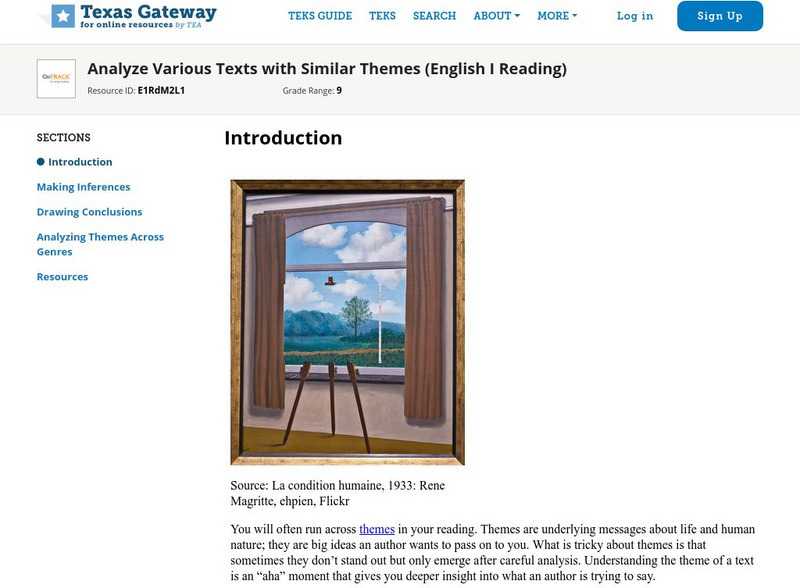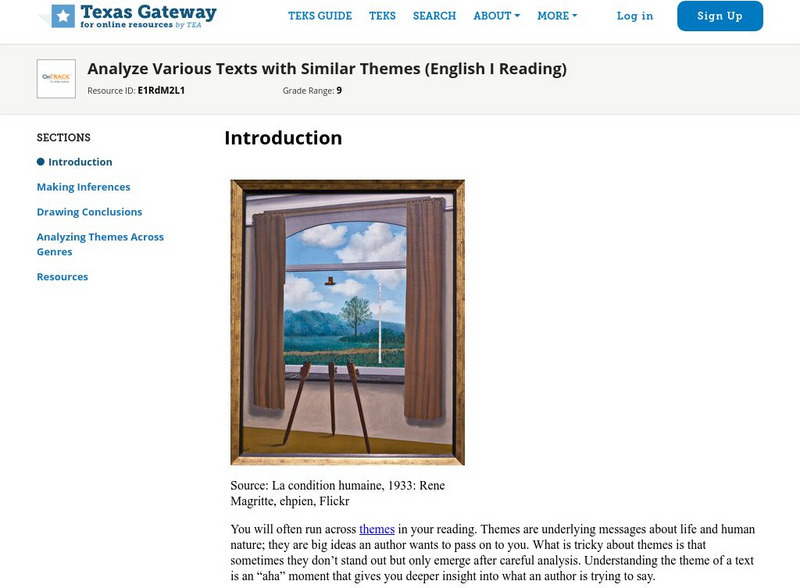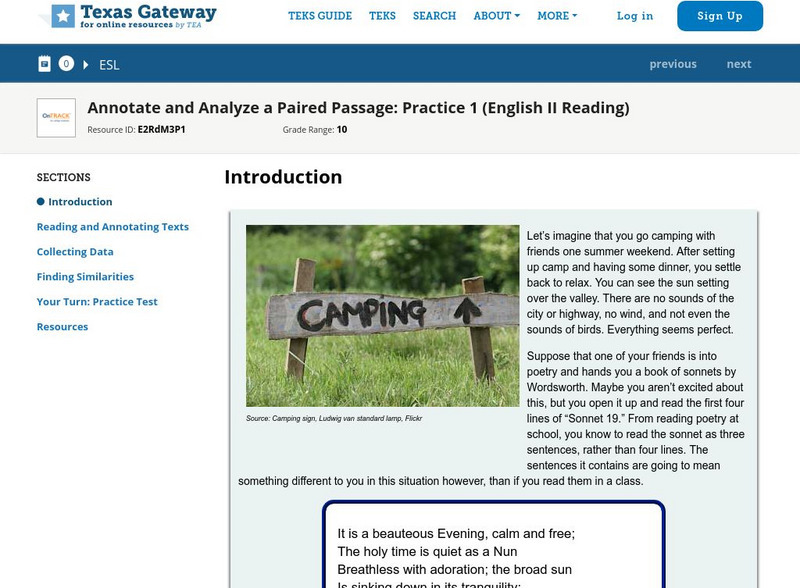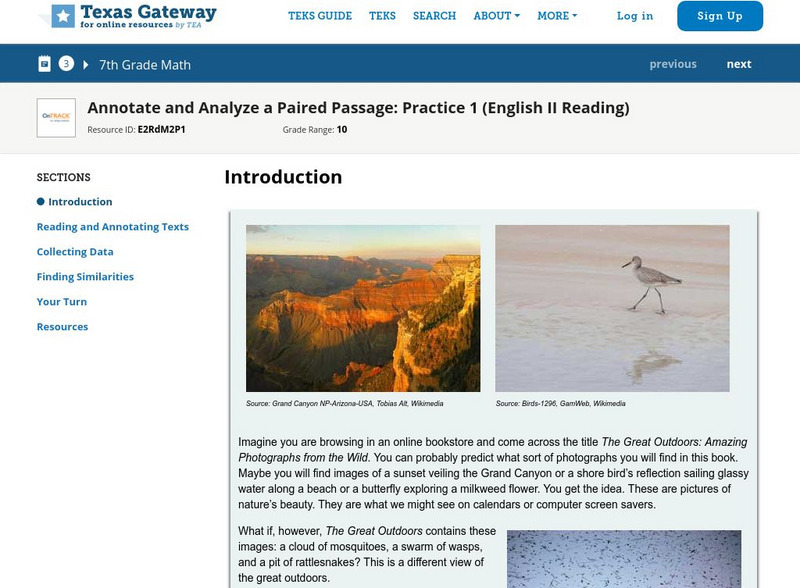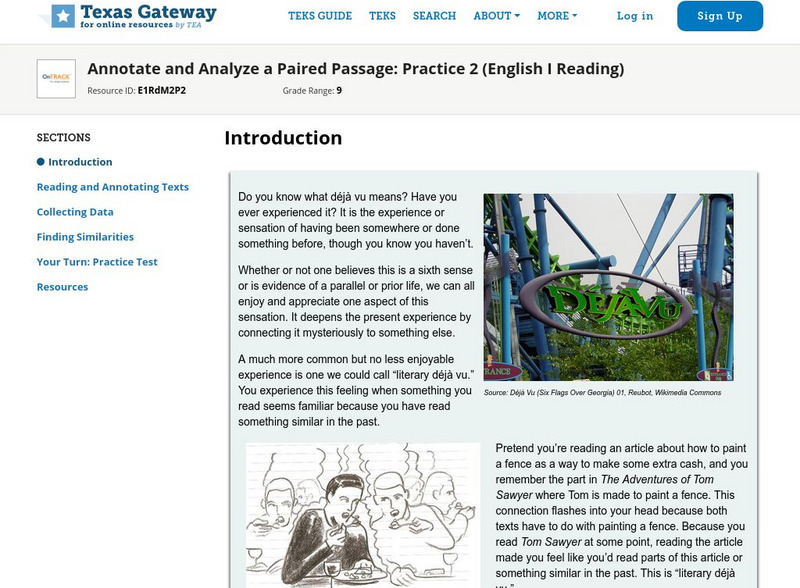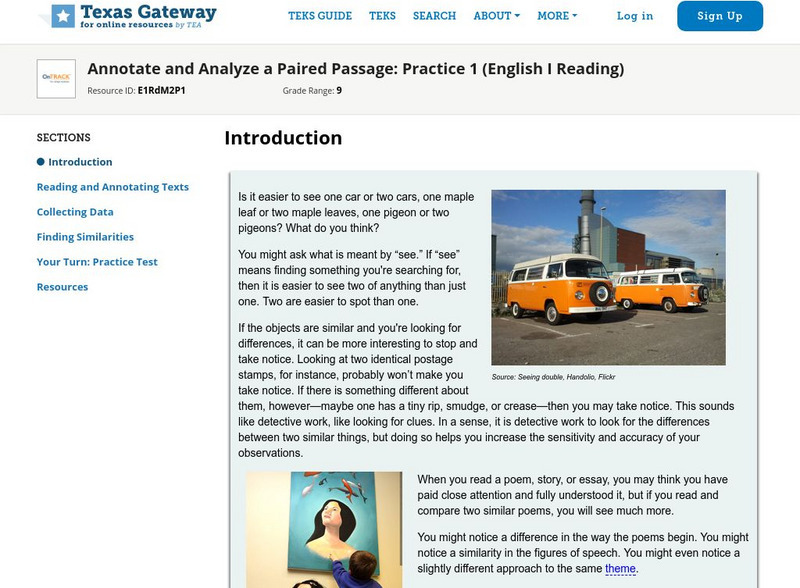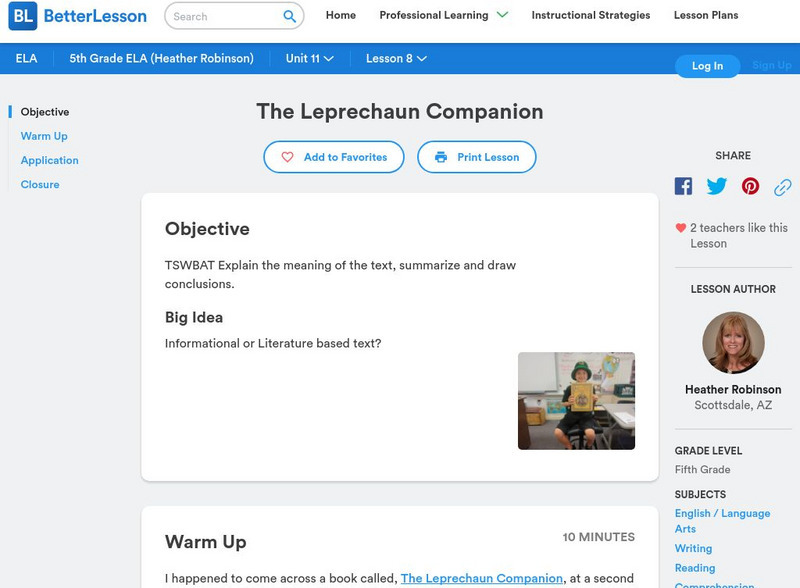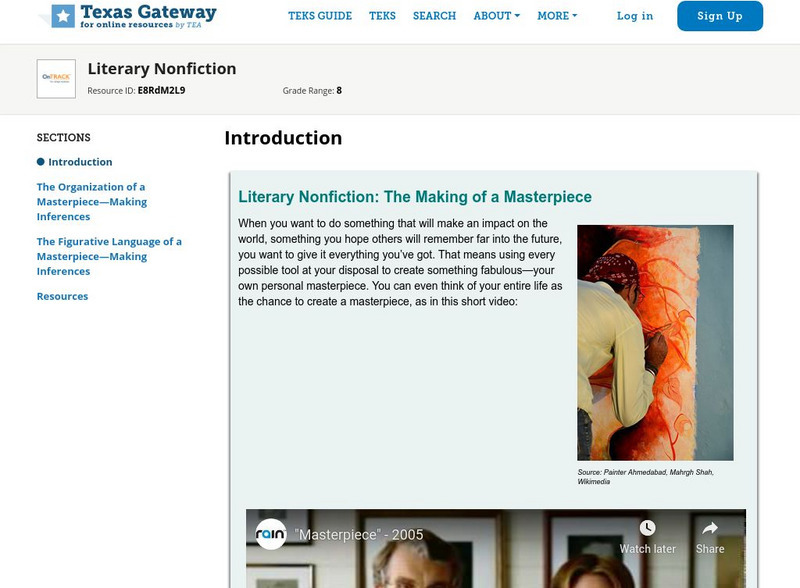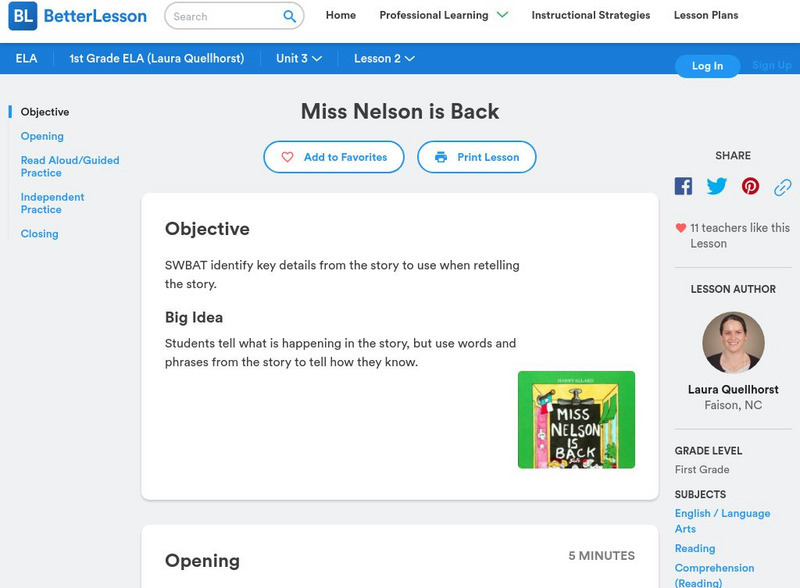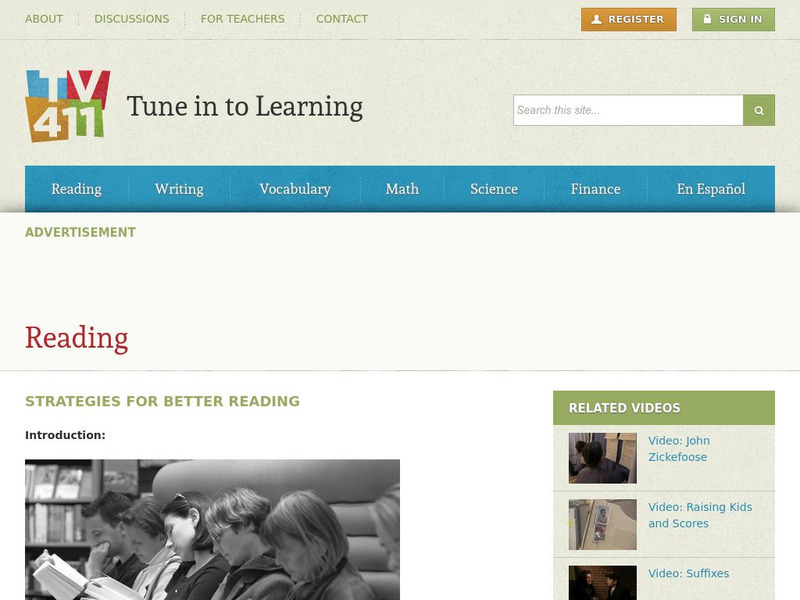Hi, what do you want to do?
Texas Education Agency
Texas Gateway: Annotate and Analyze a Paired Passage: Practice 1
Read and annotate paired texts in order to make inferences, draw conclusions, and synthesize ideas and details using textual evidence.
Better Lesson
Better Lesson: What the Heck Is That? Inferring the Purpose of an Object
In this lesson, 5th graders use their prior knowledge and inference skills to determine uses of unfamiliar objects. They participate in group discussions and analyze the key information they have in order to reach conclusions.
Polk Brothers Foundation Center for Urban Education at DePaul University
De Paul University: Center for Urban Education: Can Infer Meaning of Word From Context [Pdf]
Students will find a reference poster that will help students inference. Students will find step-by-step directions to help them infer meanings of new words.
Other
Author Stream: Make an Inference
A slideshow with twelve slides giving information, examples, and practice exercises on making inferences
ClassFlow
Class Flow: What Is an Inference?
[Free Registration/Login Required] This flipchart defines what an inference is and helps students understand the concept using Activote to review and practice.
Quia
Quia: Making Inferences, Summaries, and Conclusions
Read a short text and then choose the correct inference, summary, or conclusion in this Rags to Riches style game.
Texas Education Agency
Texas Gateway: Analyze Various Texts With Similar Themes (English I Reading)
You will learn how to make inferences and draw conclusions about similar themes in various texts by finding supporting evidence within the texts.
Texas Education Agency
Texas Gateway: Annotate and Analyze a Paired Passage: Practice 2
Read and annotate paired texts in order to make inferences, draw conclusions, and synthesize ideas and details using textual evidence.
Texas Education Agency
Texas Gateway: Make Inferences in Informational/expository Text
[Accessible by TX Educators. Free Registration/Login Required] By using different organizational patterns as guides, learn how to make subtle inferences and draw complex conclusions while distinguishing factual claims.
University of California
University of California at Berkeley: Understanding Science: Mystery Boxes
An interesting lesson where learners collaborate to create a visual image of what the inside of a sealed box looks like. The box has a marble or other type of sphere inside it, as well as partitions and/or ramps. Students come to...
Texas Education Agency
Texas Gateway: Literary Nonfiction
Analyze literary nonfiction, particularly speeches, by making inferences and drawing conclusions based on evidence in the text.
Texas Education Agency
Texas Gateway: Analyze Various Texts With Similar Themes
In this lesson, you will make inferences and draw conclusions about similar themes across various genres by finding supporting evidence within each of the texts. This task will require you to use your analytical reading skills, and it...
Texas Education Agency
Texas Gateway: Literary Nonfiction
[Accessible by TX Educators. Free Registration/Login Required] In this lesson, you will learn how to analyze literary nonfiction, especially speeches, by making inferences and drawing conclusions based on evidence in the text. The...
Texas Education Agency
Texas Gateway: Annotate and Analyze a Paired Passage: Practice 1
Read and annotate paired texts in order to make inferences, draw conclusions, and synthesize ideas and details using textual evidence.
Texas Education Agency
Texas Gateway: Annotate and Analyze a Paired Passage: Practice 1
In this lesson, you will read and annotate a pair of texts to make inferences, draw conclusions, and synthesize ideas and details using textual evidence. Prepare to get involved in a conversation between you and the two texts you will be...
Texas Education Agency
Texas Gateway: Annotate and Analyze a Paired Passage: Practice 2
[Accessible by TX Educators. Free Registration/Login Required] In this lesson, you will read and annotate a pair of texts to make inferences, draw conclusions, and synthesize ideas and details using textual evidence.
Texas Education Agency
Texas Gateway: Annotate and Analyze a Paired Passage: Practice 1
In this lesson, you will read and annotate a pair of texts to make inferences, draw conclusions, and synthesize ideas and details using textual evidence. You are going to look at two texts together to better understand them.
Better Lesson
Better Lesson: The Leprechaun Companion
In this lesson, 5th graders will explain the meaning of a text and its genre, summarize it, and draw conclusions. They work with a book called The Leprechaun Companion which is a cross between informational and literary text.
Texas Education Agency
Texas Gateway: Literary Nonfiction
Learn how to analyze literary nonfiction, particularly speeches, by making inferences and drawing conclusions based on evidence in the text.
McGraw Hill
Read: Does Technology Make Us Lazy?
Compare these two passages for some interesting ideas about how technology affects our lives. The questions that follow ask you to identify the main idea from either direct statement or inference.
Texas Education Agency
Texas Gateway: Understanding and Analysis of Literary Text: Meter and Rhyme
OnTRACK English II Reading, Module 3, Lessons 1-12, and Practice Lessons 1-3. Students understand, make inferences and draw conclusions about the structure and elements of poetry, drama, fiction, and literary non-fiction, and provide...
PBS
Pbs Learning Media: Is This a Map of the Underground Railroad?
In this segment from History Detectives, Anne Zorela, a map collector, believes she's found a map that outlines the routes of the Underground Railroad.
Better Lesson
Better Lesson: Miss Nelson Is Back
First graders tell what is happening in the story, but use words and phrases from the story to tell how they know.
Education Development Center
Tv411: Tune in for Reading: Reading: Strategies for Better Reading
Self-checking interactive tutorial puts reading comprehension skills to work by asking learners to make inferences, predict what happens next, and identify the main ideas in a series of short reading passages. Related materials include...





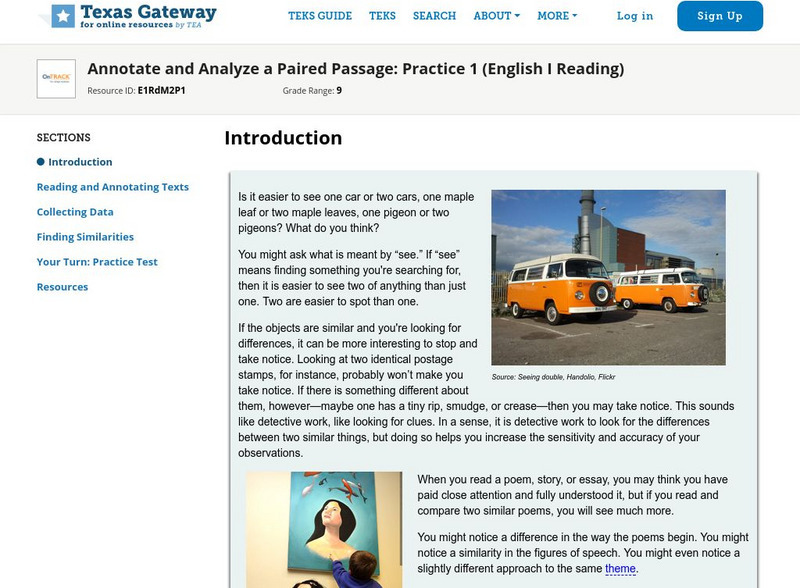

![De Paul University: Center for Urban Education: Can Infer Meaning of Word From Context [Pdf] Graphic De Paul University: Center for Urban Education: Can Infer Meaning of Word From Context [Pdf] Graphic](https://static.lp.lexp.cloud/images/attachment_defaults/resource/large/FPO-knovation.png)


